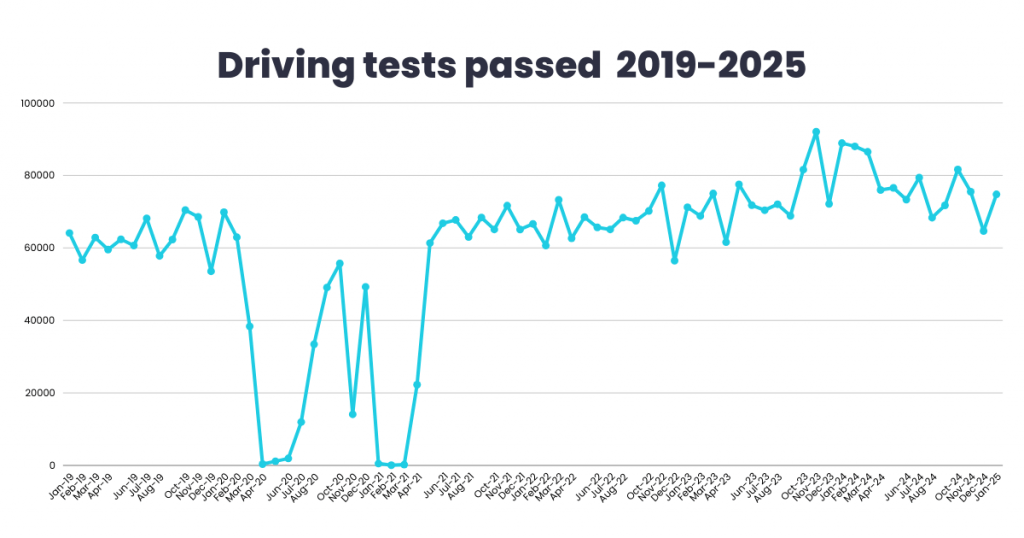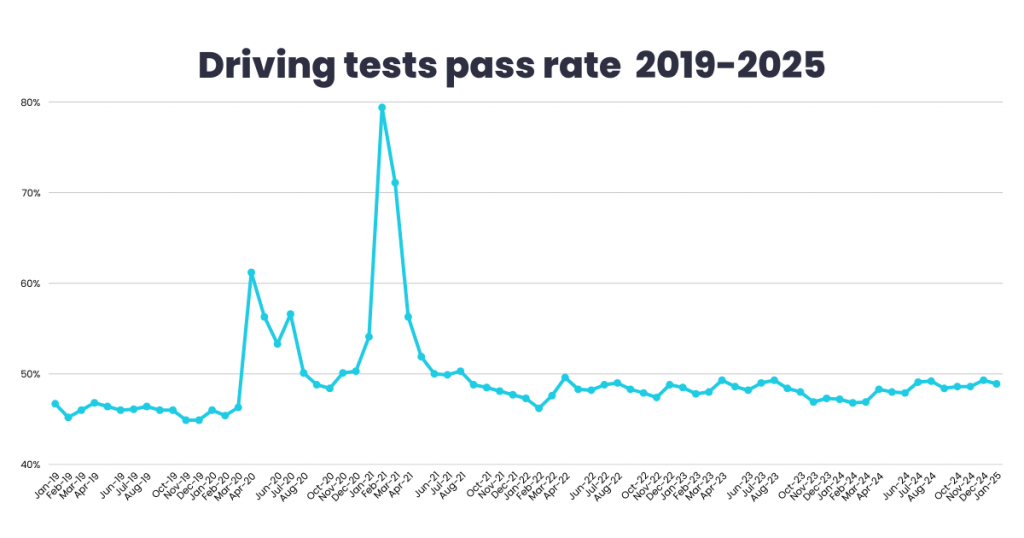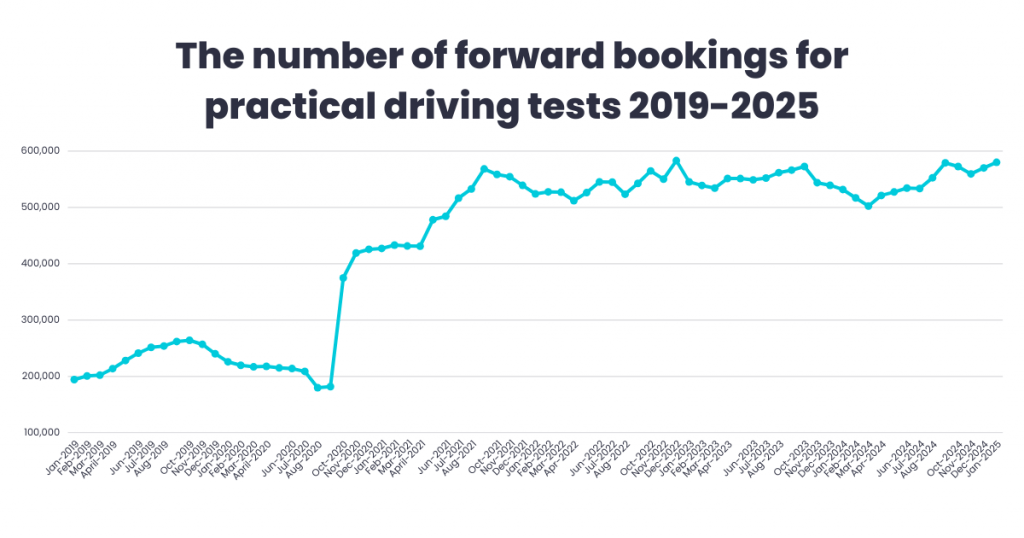Last Updated on May 6, 2025
When discussing the practical driving test, it’s important to understand the trends surrounding driving tests and other factors that can impact the tests themselves. This information is vitally important, ranging from learner drivers wishing to book their test, to insurance providers and driving instructors. The practical driving test is a key milestone in a lot of people’s lives. For those who want to learn how to drive, it’s essential they understand the practicalities surrounding the driving test to adjust their expectations and give them an insight in what lies ahead.
In this blog post, we’ll dive deep into valuable driving test data, focusing on the number of tests conducted, and passed, as well as forward bookings (all scheduled/booked in driving tests) over a six-year period from January 2019 to January 2025. Using official government figures, we’ll take a look at how external factors, such as the Covid-19 pandemic, dramatically affected the driving test system, and how demand for tests and forward bookings has evolved since then as well as the long-lasting impacts since Covid, including the current driving test backlog we’ve seen in 2025.
The Number of Driving Tests Conducted (January 2019 – January 2025)

From the start of 2019 to early 2025, the number of driving tests conducted in Great Britain has fluctuated significantly. In 2019, the figures were relatively stable, averaging around 135,000–150,000 per month. However, in March 2020, the Covid-19 pandemic started which results in a drastic collapse in driving tests, with the majority of tests cancelled and/or postponed. April 2020 recorded just 606 driving tests, which was a 99.5% decrease compared to January 2020 with testing remaining extremely limited throughout mid-2020.
By late 2020 and 2021, testing volumes slowly started to recover, although the nation-wide lockdowns continued to cause disruptions meaning there were very few tests available and able to be conducted. By 2022 and beyond, there was a gradual stabilisation and by the start of 2024, test numbers had increased significantly and were consistently exceeding pre-pandemic volumes, highlighting how demand rebounded strongly.
Summary
- Highest number of tests conducted: November 2023 with 196,481 tests.
- Lowest number of tests conducted: February 2021 with just 68 tests.
- Largest post-Covid recovery: By late 2022, monthly test numbers consistently surpassed 140,000.
- Overall trend: Sharp dip during 2020–2021, strong recovery into 2023–2025.
The Number of Driving Tests Passed and Pass Rate
Number of Driving Tests Passed:

Pass Rate:

When it comes to looking at how many people pass their driving test, this data paints an interesting picture. Pre-pandemic, the pass rate hovered between 45–47%. However, during the Covid-19 recovery period, pass rates actually increased, peaking at 79.4% in February 2021. It’s likely that during lockdowns, only candidates with very strong chances of passing such as key workers and essential drivers, were taking tests.
From 2022 onwards, as test volumes normalised, the driving test pass rate didn’t return to what we were seeing before Covid, it actually achieved slightly higher levels than pre-pandemic figures. For example, in the first 3 months of 2020, there was an average pass rate of 45.9%, whereas for the first 3 months of 2022, the average pass rate was 47.03%.
Summary
- Highest pass rate: February 2021 at 79.4% (68 tests conducted).
- Lowest pass rate: February 2019 at 45.2% (125,264 tests conducted).
- Highest number of passes: November 2023 with 92,059 passes.
- Lowest number of passes: February 2021 with just 54 passes.
- General trend: Pass rates increased during periods of lower test volumes.
The Number of Forward Bookings for Practical Driving Tests

Forward bookings refers to practical driving tests that are scheduled in the system at any one time. Pre-Covid, forward bookings hovered just below or around the 200,000 mark. However, post-2020, the backlog of cancelled tests, new demand, and limited examiner capacity led to a significant increase in the number of forward bookings.
By January 2025, forward bookings had ballooned to 580,067 which was nearly three times higher than January 2019 levels, representing an approximate 198% increase. This backlog was especially problematic during 2020 and 2021 with large numbers of tests being repeatedly cancelled and rescheduled. Although volumes had stabilised in 2024, on the approach to 2025, the long-term impact of the Covid-19 backlog is still very much present and as of April 2025, driving test waiting times across the UK remain extremely high with three quarters of driving test centres at maximum wait time.
Summary
- January 2019 forward bookings: 194,438.
- January 2025 forward bookings: 580,067.
- Percentage increase: ~198% over six years.
- Main dip: April 2020 to July 2020.
- Long-term impact: The backlog has worsened even further into 2025.
Conclusion
Between January 2019 and January 2025, the number of driving tests conducted, passed and forward bookings, across Britain faced extraordinary changes. The government data throughout this blog highlights the severe disruption caused by Covid-19, with significant drops in both tests conducted and passed throughout the years of 2020 and 2021. As a result of this, the demand for practical driving tests has since soared, reflected clearly by the tripling of forward bookings since January 2019 to January 2025. Since driving test pass rate has slowly stabilised post-pandemic, it’s clear that learner drivers today face much longer wait times and likely more pressure than those who learned pre-2020.
FAQs
Unfortunately, many learners fail their first driving test. It’s very common to need more than one attempt before getting a full licence, and it’s often just part of the learning process.
As of January 2025, the pass rate stands at 48.9%, slightly higher than pre-pandemic averages.
No, despite efforts to catch up, forward bookings in January 2025 were almost 200% higher than in January 2019, and waiting times remain lengthy.
During lockdowns, only key workers or essential drivers could book tests, leading to a higher concentration of well-prepared candidates and thus higher pass rates.
Pre-pandemic figures show approximately 1.6–1.7 million tests conducted annually, post-pandemic numbers are higher as the DVSA tries to tackle the backlog.









